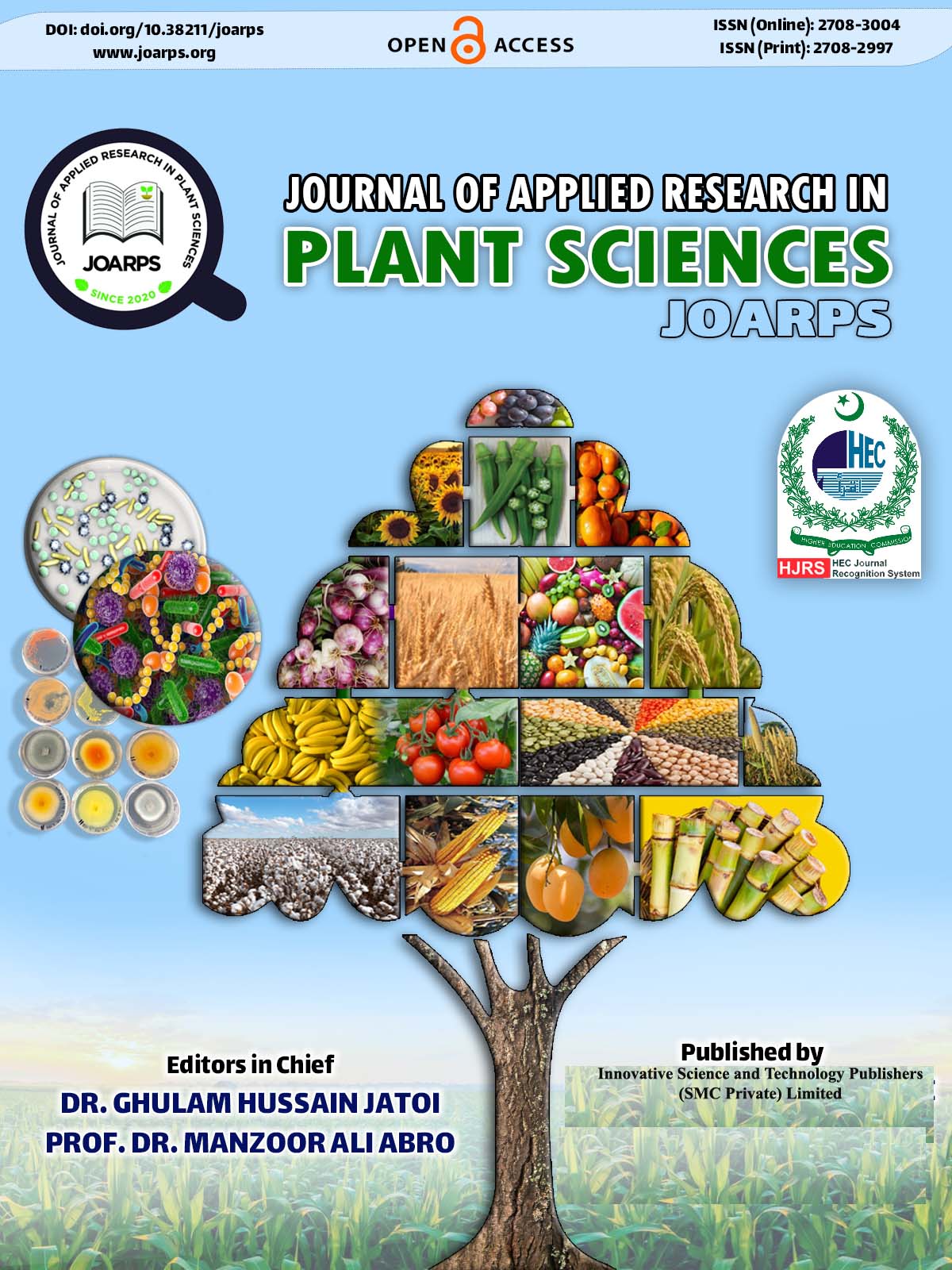Fruit Bagging: An Approach for Control of Fruit Fly Infestation and Quality Improvement in Guava
DOI:
https://doi.org/10.38211/joarps.2024.05.206Keywords:
Fruit wrapping, eco-friendly, bagging material, Fruit fly, Disease incidence, organoleptic evaluationAbstract
This study executed at experimental site of Horticultural Research Institute, Faisalabad (central Punjab) during March- July 2020-2021 to scrutinize the impact of fruit bagging to control fruit fly infestation and overall quality of guava fruit. Three bagging materials viz. butter paper, brown paper (Chinese), non-woven selected for the research purpose and unwrapped fruits were taken as control treatment (To). The research was planned according to randomized complete block design (RCBD) replicated thrice. All the treatments exhibited significant impact on different traits evaluated. Enhanced fruit firmness, fruit size, ascorbic acid contents and fruit weight noted in wrapped fruits in comparison to un-wrapped fruit. Fruits attained maximum size (3108.25mm2) and weight (133.25a g) under brown paper bag followed by non-woven bag (3091mm2) and (131g) respectively. Total soluble solid (TSS) contents of the fruit were observed maximum (10.18 Brix) in non-woven bag whereas highest titratable acidity (0.77%) was recorded under control treatment. Highest ascorbic acid contents (214.25mg /100g) were recorded in non-woven bag. Disease incidence (2.25%) and fruit fly infestation (2.13%) were found minimum in non-woven bag. Among all the treatments, non-woven material was observed to be the best to control fruit fly infestation as well as overall improvement in Guava fruit quality.
Downloads
References
Abbasi, N. A., Amjad, M., Chaudhary, M., Ikram, A., Hussain, A., & Ali, I. (2014). On tree fruit bagging influences quality of guava harvested at different maturity stages during summer. International Journal of Agriculture and Biology, 16(3),43-549.
Ali, M.M., Anwar, R., Yousef, A.F., Li, B., Luvisi, A., De Bellis, L. and Chen, F. (2021). Influence of Bagging on the Development and Quality of Fruits. Plants, 10(2): 358. DOI: https://doi.org/10.3390/plants10020358
Amarante, C., Banks, N. H., & Max, S. (2002). Preharvest bagging improves packout and fruit quality of pears (Pyrus communis). New Zealand Journal of Crop and Horticultural Science, 30(2), 93-98. DOI: https://doi.org/10.1080/01140671.2002.9514203
Badii, K.B., Billah, M.K., Afreh-Nuamah, K., Obeng-Ofori, D & Nyarko, G. (2015). Review of the pest status, economic impact and management of fruit-infesting flies (Diptera: Tephritidae) in Africa. African Journal of Agricultural Research, 10(12):1488-1498. DOI: https://doi.org/10.5897/AJAR2014.9278
Dolkar, D., Bakshi, P., Gupta, M., Wali, V.K., Kumar, R., Hazarika, T.K. & Kher, D. (2017). Biochemical changes in guava (Psidium guajava) fruits during different stages of ripening. Indian Journal of Agricultural Science, 87(2): 257-260. DOI: https://doi.org/10.56093/ijas.v87i2.67659
Edirimanna, E., Amarathunga, D., Amarasena, B & Kirinde, T. 2015. Effect of bagging materials and bag colour on fruit weight and quality of guava (Psidium guajava L.). Annals Sri Lanka Department Agriculture, 17: 297-302.
Faoro, I.D. & Mondardo, M. (2004). Ensacamento de frutos de pereira cv. Housui. Revista de. Brasileira. Fruticultura. 26(1): 86-88. DOI: https://doi.org/10.1590/S0100-29452004000100023
Fernandes, M.B., Mizobutsi, E.H., Rodrigues, M.L.M., Ribeiro, R.C.F., Mizobutsi, G.P.& Pinho, D.B. (2019). Bagging time of ‘Prata-anã’ banana regarding anthracnose control. Revista Brasileira de Fruticultura, 41(1): 56-66. DOI: https://doi.org/10.1590/0100-29452019066
Frank, D. (2018). Evaluation of Fruit Bagging as a Pest Management Option for Direct Pests of Apple. Insects, 9(4): 178. DOI: https://doi.org/10.3390/insects9040178
HamediSarkomi, F., Moradinezhad, F. & Khayat, M. (2019). Pre-harvest bagging influences sunburn, cracking and quality of pomegranate fruits. Journal of Horticulture and Postharvest Research, 2(2): 131-142.
Hans, Y.S.H., 1992. The Guide Book of Food Chemical Experiment. Pekin Agricultural University Press, Pekin
Hortwitz, W., 1960. Official & Tentative Methods of Analysis, 9th edition, pp: 314-320. Association of Official Agriculture Chemists, Washington, DC, USA.
Jimenez-Escrig, A., Rincon, M. & Pulido, R. (2001). Guava fruit (Psidium guajava L.) as a new source of antioxidant, dietary fiber. Journal of Agricultural and Food Chemistry, 49: 5489-93. DOI: https://doi.org/10.1021/jf010147p
Jing, C.; Feng, D.; Zhao, Z.; Wu, X. & Chen, X. (2020). Effect of environmental factors on skin pigmentation and taste in three apple cultivars. Acta Physiol. Plant. 42, 69. DOI: https://doi.org/10.1007/s11738-020-03039-7
Jing, L., Youhong, C., Zhimei, Y. & Xiaogang, L. (2008). Effects of bagging on the quality of pear fruit and pesticide residues. Acta Horticulturae, 772:315-318. DOI: https://doi.org/10.17660/ActaHortic.2008.772.52
Kim, Y.H., Kim, H.H., Youn, C.K., Kweon, S.J., Jung, H.J. & Lee, C.H. (2008). Effects of bagging material on fruit colouration and quality of ‘Janghowon Hwangdo’ peach. Acta Horticulturae, 772: 81-86. DOI: https://doi.org/10.17660/ActaHortic.2008.772.9
Lee, S.K. & Kader, A.A. (2000). Preharvest and postharvest factors influencing vitamin C content of horticultural crops. Postharvest Biology and Technology, 20(3): 207-220. DOI: https://doi.org/10.1016/S0925-5214(00)00133-2
Lin, J., Wang, J.H., Li, X.J. & Chang, Y.H. (2012). Effects of bagging twice and room temperature storage on quality of ‘Cuiguan’ pear fruit Acta Horticulturae, 934: 837-40. DOI: https://doi.org/10.17660/ActaHortic.2012.934.110
Macan, A.M., Kraljevic, T.G. & Raic-Malic, S. (2019). Therapeutic perspective of vitamin c and its derivatives. Antioxidants 8: 1-36. DOI: https://doi.org/10.3390/antiox8080247
Mathooko, F.M., Kahangi, E.M., Runkuab, J.M., Onyangob, C.A. & Owinob, W.O. (2011). Pre-harvest mango (Mangifera indica L.‘Apple’) fruit bagging controls lenticel discolouration and improves postharvest quality. Acta Horticulturae, 906: 55-62. DOI: https://doi.org/10.17660/ActaHortic.2011.906.7
Matsumoto, K., Fujita, T.& Sato, S. (2018). Effects of 1-MCP and Pre-harvest Fruit Bagging Treatments on Cold Storability of the Red-fleshed Apple ‘Kurenainoyume’. The Horticulture Journal, 87(4), 443-451. DOI: https://doi.org/10.2503/hortj.OKD-135
Meena, K. R. & Maji, S. (2016). Effect of Bagging on Fruit Quality of Guava. International Journal of Bio-resource and Stress Management, 7(2): 330- 333.
Mitra, S.K., Gurung, M.R. & Pathak, P.K. (2008). Sustainable guava production in West Bengal, India. Acta Horticulture, 773:179-182. DOI: https://doi.org/10.17660/ActaHortic.2008.773.25
Mondal, C.K., Garain, P.K., Mitra, N.L. & Maji, A. (2015). Bio-friendly management of guava fruit fly (Bactrocera correcta Bezzi) through wrapping technique. Journal of Applied and Natural Science, 7(1):358-363. DOI: https://doi.org/10.31018/jans.v7i1.616
Morera-Montoya, R., Blanco-Metzler, H. & Luis-Loria, C.R. (2010). Evaluation of different bagging materials for the control of the fruit fly Anastrephasp. (Diptera, Tephritidae) and fruit pathogens in Taiwanese guava fruits (PsidiumguajavaL.). Acta Horticulturae, 849:283-292. DOI: https://doi.org/10.17660/ActaHortic.2010.849.33
Moura, E.S., Azevedo, F.R., Santos, C.A.M., Nere, D.R.& Azevedo, R. (2011). Controle de pragas da goiabeira (Psidium guajava) com ensacamento de frutos. Cadernos de Agroecologia, 6(2):1-5.
Nascimento, W.M.O., Müller, C.H., Araújo, C.S. & Flores, B.C. (2011). Ensacamento de frutos de abiuvisando à proteção contra o ataque da mosca-das-frutas. Revista Brasileira de Fruticultura, 33(1):48-52. DOI: https://doi.org/10.1590/S0100-29452011000100007
Oliveira, P.G., Queiróz, M.A., Castro, J.M.C., Ribeiro, J.M., Oliveira, R.S. & Silva, M.J.L. (2019). Reaction of Psidium SPP. accessions to different levels of inoculation with Meloidogyne enterolobii. Revista Caatinga, 32(2): 419-428. DOI: https://doi.org/10.1590/1983-21252019v32n215rc
Prabha, S., Kumari, K. & Deb, P. (2018). Effect of fruit bagging on Physico-chemical properties of Pineapple cv. Mauritius. International Journal of Current Microbiology and Applied Science, 7: 4876-4885.
Qin, S.J., Li, F.D. & Lv, D.G. (2012). Effect of preharvest bagging on fruit epidermis epiphyte community structure of “Red Fuji” apple. Middle-East Journal of Scientific Research, 11:1475-80.
Rahman, H., Akter, A., Rahman, J., Riad, M.I & Rahman, M.M. (2017). Effect of fruit thinning and bagging on the yield and quality of guava. Research & Reviews: Journal of Agricultural Science and Technology, 6(1): 20-27.
Rajametov, S. & Nurbekov, A. (2020). Effects of different types of paper bags on ‘Golden Delicious’ apple fruits. Acta Horticulturae, 1275: 415-418. DOI: https://doi.org/10.17660/ActaHortic.2020.1275.57
Sarker, D., Rahman, M. & Barman, J. (2009). Efficacy of different bagging materials for the control of mango fruit fly. Bangladesh Journal of Agricultural Research, 34(1):165-168. DOI: https://doi.org/10.3329/bjar.v34i1.5766
Sharma, R.R and Nagaraja A. (2016). Bagging guava fruits to reduce fruit fly incidence. ICAR News, 22(2):3-4.
Sharma, R.R., Nagaraja, A., Goswami, A.K., Thakre, M., Kumar, R. & Varghese, E. (2020). Influence of on-the-tree fruit bagging on biotic stresses and postharvest quality of rainy-season crop of ‘Allahabad Safeda’ guava (Psidium guajava L.). Crop Protection,135:105216. DOI: https://doi.org/10.1016/j.cropro.2020.105216
Sharma, R.R., Pal, R.K., Asrey, R., Sagar, V.R., Dhiman, M.R. & Rana, M.R. (2013). Pre-harvest fruit bagging influences fruit color and quality of apple cv. Delicious. The Journal of Agricultural Science, 4(9): 443-448. DOI: https://doi.org/10.4236/as.2013.49059
Sharma, R.R., Reddy, S.V.R. & Jhalegar, M.J. (2014). Pre-harvest fruit bagging: A useful approach for plant protection and improved post-harvest fruit quality-A review. The Journal of Horticultural Science and Biotechnology, 89(2):101-113. DOI: https://doi.org/10.1080/14620316.2014.11513055
Singh, B.P., Singh. R.A., Singh, G. & Killadi, B. (2007). Response of bagging on maturity, ripening and storage behavior of winter guava. Acta Horticulturae, 735:597-601. DOI: https://doi.org/10.17660/ActaHortic.2007.735.77
Singh, R.K. Shah, N.I. & Solanki, P.D. (2017). Influence of fruit bagging on chemical quality of mango (Mangifera indica L.) varieties. International Journal of Plant and Soil Science, 18(3):1-7. DOI: https://doi.org/10.9734/IJPSS/2017/33987
Srivastava, K.K., Soni, K.S., Kumar, D. & Dwivedi, S.K. (2023). Effect of different bagging materials on guava fruit physiology and its quality attributes. Plant Physiology Reports. 28(2):238–246. https://doi.org/10.1007/s40502-023-00733-9 DOI: https://doi.org/10.1007/s40502-023-00733-9
Steel, R.G.D., J.H. Torrie & D.A. Dicky.(1997). Principles and Procedures of Statistics: A Biometrical Approach. 3rd Ed. McGraw Hill Book Co., New York.
Susanto, S., Melati, M. & Aziz, S.A. (2019). Pruning to improve flowering and fruiting of ‘Crystal’ guava. AGRIVITA Journal of Agricultural Science, 41(1): 48-54. DOI: https://doi.org/10.17503/agrivita.v41i1.1954
Teixeira, R., Boff, M.I.C., Amarante, C.V.T., Steffens, C.A. & Boff, P. (2011). Effects of fruit bagging on pests and diseases control and on quality and maturity of “Fuji Suprema” apples. Bragantia, 70: 688-695. DOI: https://doi.org/10.1590/S0006-87052011000300027
Tokairin, T.O., Cappello, F.P. & Spósito, M.B. (2014). Production cost of table guavas produced with and without bagging: case study. Revista Brasileira de Fruticultura, 36: 542-549. DOI: https://doi.org/10.1590/0100-2945-347/13
Tran, D.H., Yen, C.R & Chen, Y.H. (2015) Effect of bagging on fruit characteristics and physical fruit protection in red pitaya (Hylocerus spp.). Biological Agriculture and Horticulture ;31(3):158- 166. DOI: https://doi.org/10.1080/01448765.2014.991939
Wang, Y.J., Yang, C.X., Liu, C.Y., Xu, M., Li, S.H., Yang, L. & Wang, Y.N. (2010). Effects of bagging on volatiles and polyphenols in ‘Wanmi’ peaches during endocarp hardening and final fruit rapid growth stages. Journal of Food Science, 75(9):455-460. DOI: https://doi.org/10.1111/j.1750-3841.2010.01817.x
Watanawan, A., Watanawan, C. & Jarunate, J. (2008). Bagging “Nam Dok Mai #4” mango during development affects colour and fruit quality. Acta Horticulturae, 787:325-328. DOI: https://doi.org/10.17660/ActaHortic.2008.787.40
Xu, G.; Nie, J.; Wu, Y.; Yan, Z & Ye, M. (2018). The effects of fruit bagging on residue behavior and dietary risk for four pesticides in apple. Scientific Reports, 8(1):14348. DOI: https://doi.org/10.1038/s41598-018-32358-6
Xu, H.X., Chen, J.W & Xie, M. (2010). Effect of different light transmittance paper bags on fruit quality and anti-oxidant capacity in loquat. Journal of the Science of the Food and Agriculture, 90(11):1783-88. DOI: https://doi.org/10.1002/jsfa.4012
Zhou, X.B & Guo, X.W. (2005). Effects of bagging on the fruit sugar metabolism and invertase activities in “Red Globe” grape during fruit development. Journal of Fruit science, 26:30-33.
Downloads
Published
How to Cite
Issue
Section
License
Copyright (c) 2024 Sahar Rashid, Hira Faiz, Muhammad Maaz Aziz, Komal Aslam, Humaira kausar, Obaid Ullah Khan, Allah Bakhsh

This work is licensed under a Creative Commons Attribution 4.0 International License.







